Understanding Academic Staff Attitudes Toward GenAI in Teaching
DOI:
https://doi.org/10.26034/fr.jehe.2025.8397Keywords:
Generative AI, Higher Education, faculty attitudes, TPACK, technological pedagogical content knowledge, personal innovativeness in IT, PIIT, technology acceptance model, perceived usefulnessAbstract
This study examines the attitudes of academic staff toward the use of generative artificial intelligence (GenAI) in higher education teaching. Focusing on faculty members at a college in Israel, the study explores how attitudes are associated with self-reported levels of technological pedagogical content knowledge (TPACK) self-efficacy, personal innovativeness in IT (PIIT), and two perceptual constructs drawn from the Technology Acceptance Model (TAM): perceived usefulness and perceived ease of use. A cross-sectional survey design was used, with data collected from 84 lecturers. Correlation and hierarchical regression analyses revealed that both PIIT and TPACK self-efficacy were positively associated with attitudes toward GenAI, with perceived usefulness and ease of use emerging as significant mediators. Specifically, the effect of TPACK self-efficacy on attitudes was fully mediated by these perceptual variables, while PIIT retained a significant direct effect. The findings suggest that faculty attitudes toward GenAI are shaped by both individual dispositions and evaluative judgments about the tool’s pedagogical relevance and usability. This research contributes to the growing literature on AI in education by providing empirical evidence on the attitudinal antecedents relevant to faculty engagement and may inform institutional strategies that support the thoughtful and differentiated integration of GenAI in teaching.
Downloads
Published
How to Cite
Issue
Section
License
Copyright (c) 2025 Clara Hope Rispler, Michal Mashiach-Eizenberg, Gila Yakov

This work is licensed under a Creative Commons Attribution-NonCommercial-ShareAlike 4.0 International License.
Journal articles of Globethics Publications are published under the open Creative Commons License Attribution-NonCommercial-ShareAlike 4.0 International (CC BY-NC-SA 4.0), which guarantees the rights of licensor and allows free use and re-use to the licensees (the readers) who can: 1) Share — copy and redistribute the material in any medium or format 2) Adapt — remix, transform, and build upon the material provided appropriate credit is given and similar license is used in case of such adaptations. Content should not be used for commercial purposes. Each article (the version of record) can be deposited by the author on their academic institutional repository or personal author webpage.







